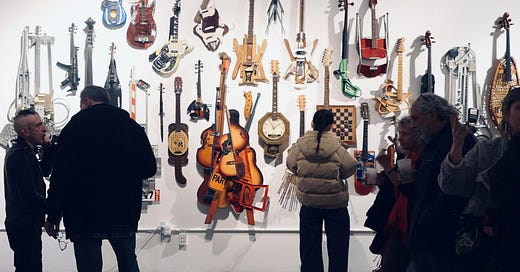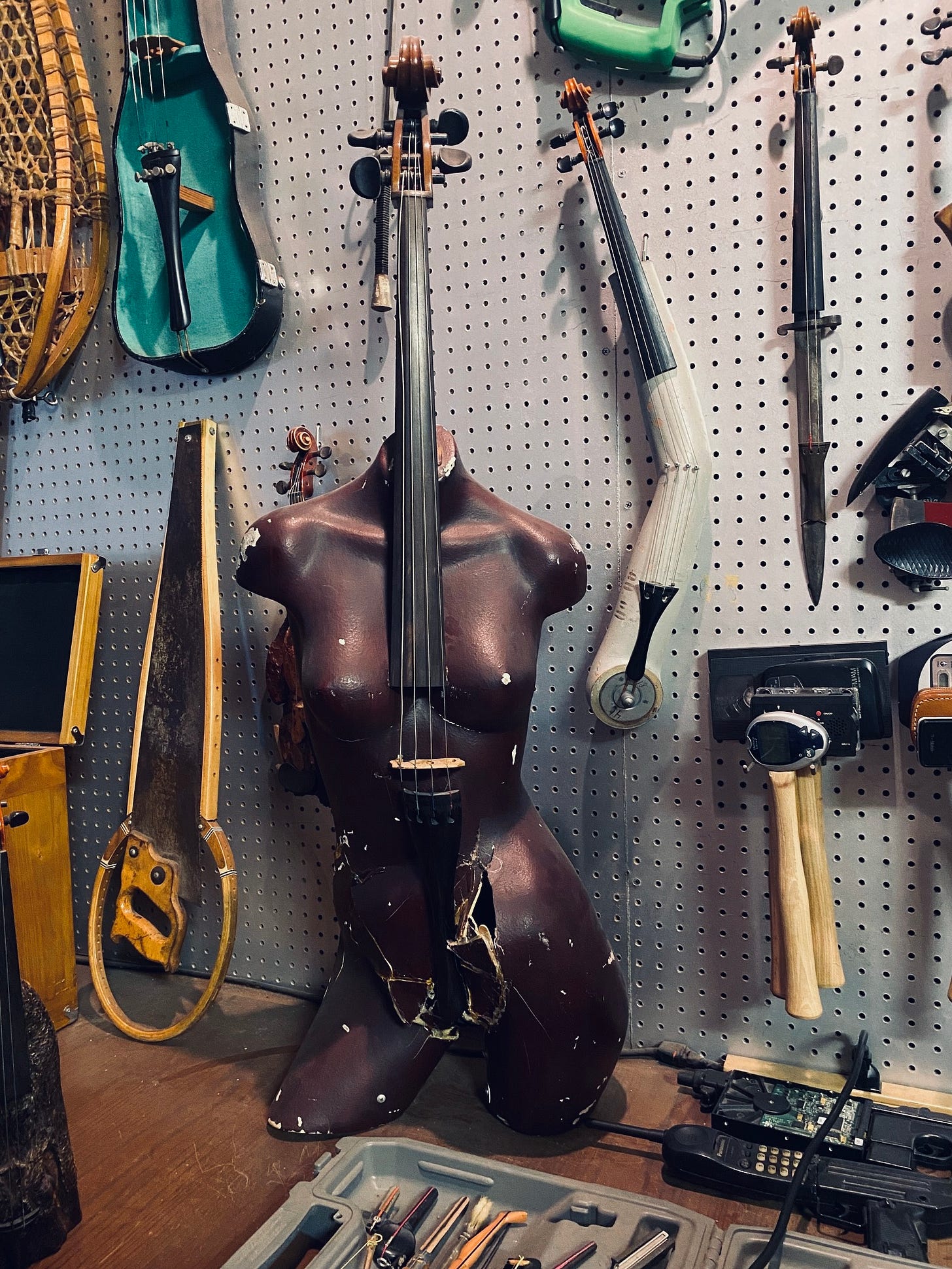Dangling from the ceiling — in the middle of Ken Butler’s newly-opened retrospective, “Instrumental,” at Culture Lab LIC — is a rather unusual trapeze artist.
Rotating slowly, as if disturbed by even the slightest gust of air, a fabric dress form. Outfitted with a cello neck and fingerboard.
The bridge, quaking under the weight of the strings, presses sharply into the stomach, on which there are two F-holes, painted back.
Above them, ironclad nipples, which complement the rather pubic tailpiece.
This sculpture, titled Torso Cello, was one of my first introductions to Butler’s work.
Sometime last year, I came across it, quite randomly, on 1st Dibs (where you can buy it for $6,600, apparently.)
This was around the time that I was researching Man Ray’s Le Violon D’Ingres for my essay, “F-Hole,” which is, among other things, about being trans and getting tattooed.
Butler (whom I also, coincidentally, heard perform at TV Eye) calls himself a “bricoluthier” of hybrid instruments.
His work immediately resonated with me because of the way that it engages with objectification, throughout art history, of the “female” body.
And Torso Cello seemed to me to be a direct homage to Man Ray.
Butler’s show — on view through March 3 — is full of such quotations. From Surrealism. From Cubism. Even some, quite literal quotations, from Butler himself.
Printed on one wall: “Live music is the best because it’s full of mistakes.”
The idea of a “torso cello” makes sense. A cello’s back generally measures between 27 and 30 inches. My own back — as I learned while writing “F-Hole” — measures 28 inches.
It’s all about ratios, proportions. Where most people see stuff, Butler sees instruments.
A cello made from a violin case; a bass made from a guitar case. Pochettes made from scuba flippers, alligator heads, machine guns, knives, and squash rackets.
It’s all very evocative, but any subconscious meaning, Butler says, is secondary to the “thinginess” of it all.
Back in July, I reached out to Butler, who kindly invited me over to his bachelor pad-like studio.
There, I met his 16-year-old, slightly incontinent, dog, Wiley: “I have custody of him from my ex two days a week,” he said.
In addition to the Torso Cello, which was made from his mother’s dress form, Butler showed me a bass made from an upside-down mannequin, which he found on the street (“I got some weird looks on the subway,” he said).
Another “torso cello” was broken after it was lent to a neighbor who was having a party (Butler said it felt symbolic, as if saying something about “violence towards Black women”).
Though none of the “torsos” were in playing condition, I was allowed to fiddle around on a Styrofoam cello made from a crutch, which sounded a lot better than I expected.
Butler also showed me his Urban Grand Piano — which you yourself can play as part of “Instrumental” — with 12 keys that control lights, tape recorders, and live radio.
I realized, in that moment, that I was in the presence of a mad genius.
Like any good artist, Butler self-mythologizes liberally. Displayed as part of “Instrumental,” Butler’s first-ever hybrid violin, dated 1978, which he made from an axe.
When Butler was in art school, his uncle, who was a chiropractor in Idaho, lent him some X-rays from which to make art. That was when Butler first realized the ghostly forms (curved from scoliosis) resembled guitars.
Indeed, there’s a predominance of skeletons in “Instrumental,” especially in his life-size collages and paintings, all of them being a kind of “memento mori.”
That sentiment is all-too familiar to Butler. As we sat on the artist’s sunken sofa, after about two hours of excited chatting, Butler suddenly lowered his voice.
He said that, ever since getting a liver transplant (he had cancer in 2007), he says he thinks of himself, too, as a sort of “hybrid” or “assemblage.” It’s given him new insight into his art.
I found it so moving that Butler (an older straight guy) and I (a young nonbinary person) could have that feeling in common.









Thanks so much Max, much appreciated!
Please note: The First Dibs offer expired long ago .. if interested in purchasing, contact Tess Howsam at Culture Lab LIC (it’s much less) .. Ken